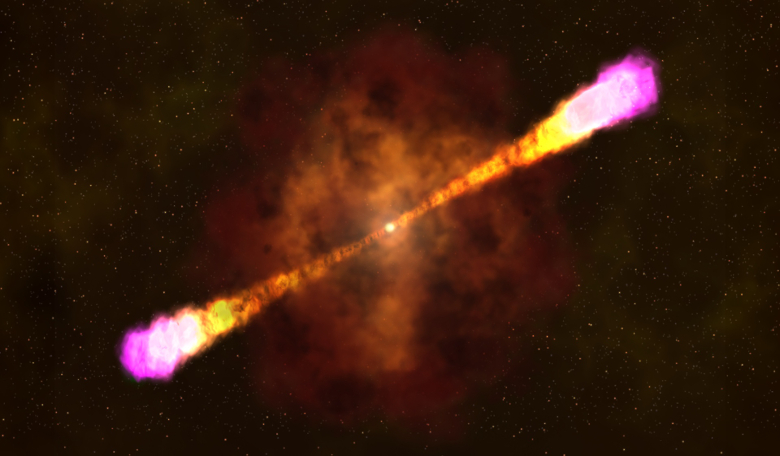Scientists have for the first time used the Atacama Large Millimetre/Submillimetre Array (ALMA) to study the afterglow of a gamma-ray burst (GRB) – an event classed as one of the most violent explosions in the Universe.
GRB’s are somewhat of an enigma; much is known about them, but at the same time, it can also be said that little is also known about them. What is certain is that GRB events are characterised by a short flash of gamma-ray photons followed by a long lasting afterglow that can be observed across a broad spectrum of wavelengths. They can also be classified based on how ‘hard’ they are and how long they last. Hard radiation is a colloquial term applied to radiation which is at the higher end of the energy spectrum. Hard GRBs therefore typically last for less than two seconds, whereas soft GRBs persist for two seconds or more.
These incredibly powerful bursts are thought to originate from highly magnetised relativistic jets with either magnetic dissipation or internal shocks in the photosphere of the jet causing the GRB emission. The afterglow on the other hand is thought to originate from external shocks caused by the jet’s interaction with the interstellar medium (ISM).
To properly determine the physical properties of GRB emission, a wide range of accurate multi-wavelength observations are needed and those in the millimetre/sub-millimetre range have in the past been lacking. Now, with the help of ALMA, a large international team of astronomers have used a selection of telescopes to study the afterglow of GRB 110715A at 17 different wavelengths – from X-ray to radio bands – starting 81 seconds after the burst and extending up to 74 days later.
Deep imaging of the region from where GRB 110715A originated from, revealed a faint host galaxy with a low luminosity - lower than most other GRB host galaxies – and considering the very low ionisation environment of the galaxy, the team suggest that all evidence points to a small dwarf host galaxy, maybe in its initial star-forming phase.
In order to further understand more about the the physical processes involved in the explosion behind GRB 110715A and the medium in which it occurred, the team fitted their data with a variety of models, including different density profiles and energy injections. However the team state that “although the general behaviour can be roughly described by these models, none of them are able to fully explain all data points simultaneously.” Nonetheless the team further state that, “the best model implies a forward shock evolving through a wind environment with a termination shock.”
While this research may not have conclusively proved what phenomena gave rise to GRB 110715A, with the advent of facilities such as ALMA now online to aid with observations, researchers will be able to provide high-quality data for a larger number of GRBs, thus probing GRB emission mechanisms in greater detail than ever before.
For more information on this research, see; https://arxiv.org/pdf/1610.01844.pdf











